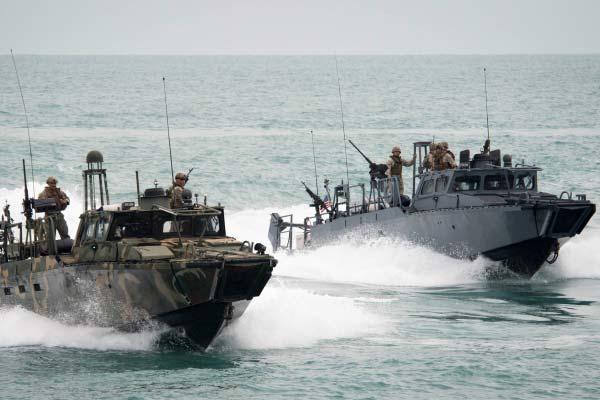The Navy's top officer said Thursday that another sailor had been relieved in the wake of an incident in which the ten sailors crewing two riverine command boats were detained by Iran in January.
Adm. John Richardson said the officer in charge of the riverine detachment in Kuwait that oversaw the two boats had also been removed in connection with an investigation that cited "lack of oversight … judgment, and his overall lack of competency as an officer-in-charge."
This officer, who wasn't identified, is now the third to be fired in connection with an incident that revealed key leadership and training failings and was manipulated as a propaganda victory for Iran.
The Navy previously announced that the commander of Coastal Riverine Squadron 3, Cmdr. Eric Rasch, and the commodore of Task Force 56, which oversaw the squadron during its Middle East deployment, Capt. Kyle Moses, had been relieved. A Navy official said the Kuwait officer-in-charge is a lieutenant and was not in a command billet, so the name is not being made public.
Richardson addressed reporters during a briefing Thursday at the Pentagon as the Navy rolled out the results of an extensive five-month investigation into the Jan. 12 detention, which highlighted failures to conduct sustainment training in theater, a lack of involved leadership, and a failure on the part of the riverine boat crews to follow proper protocol underway and code of conduct standards while detained.
Administrative actions regarding the leaders of the two boat crews are still pending, Richardson said.
Navy officials are determined to implement new policies to prevent such an incident from ever happening again, he said. As a result of the investigation, which was expanded to include four-star fleet commanders in the U.S. and elements of pre-deployment training and preparation.
Despite the errors identified on the part of sailors involved, Richardson said Iran was ultimately in the wrong when it seized the boats and detained the sailors aboard.
"The investigation concluded that Iran violated international law by impeding the boats' innocent passage transit, and they violated our sovereign immunity by boarding, searching, and seizing the boats, and by photographing and video recording the crew," he told reporters.
It's unclear how the U.S. plans to respond.
Richardson said he had made no direct contact with Iranian counterparts about the incident and the Navy's conclusion and was not aware of any efforts to do so. Publicly, Secretary of State John Kerry has only had praise for the success of diplomatic policy in negotiating for the sailors' return.
"We made our views clear in forums like this," Richardson said.
Among a sweeping list of changes to procedure, the Navy's Fifth Fleet has begun conducting monthly training assessments of forces in theater, enhanced pre-deployment training and more robust fleet certification requirements, Deputy Chief of Naval Operations Vice Adm. John Aquilino said.
Since the boats were seized after one broke down in Iranian territorial waters, the Navy has also begun no-notice inspections of deployed units' equipment and is working to implement greater leadership and oversight for geographically distributed units, Aquilino said.
Because the Navy found the riverine boat crews were not familiar enough with existing rules of engagement and the code of conduct for detainees, the service is now requiring in-person survival, evasion, resistance, and escape training for all coastal riverine personnel.
The lasting impact of the detainee incident has yet to be determined, Richardson said.
"We'll … make sure that we learn every possible lesson out of this," he said. "And we'll make it vividly clear to the United States Navy what is the expected standard and how to achieve that standard."
While the investigation concluded that the riverine sailors had acted incorrectly by surrendering to the Iranian forces with minimal protest, Richardson demurred from outlining what they should have done in that situation, citing a wish not to interfere with ongoing administrative procedures.
"Clearly the main point of the investigation is that you never want to get yourself in that position where you clearly have very few good choices," he said. "There were no good choices at that point."
-- Hope Hodge Seck can be reached at hope.seck@military.com. Follow her on Twitter at @HopeSeck.
Related Video:
American Sailor Apologizes to Iran






























